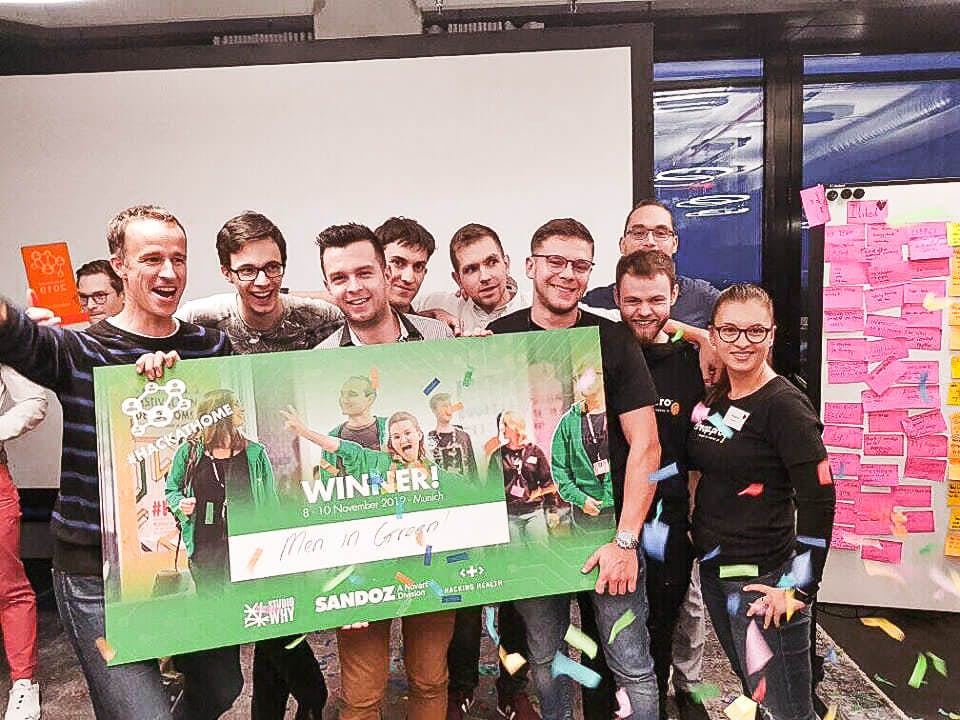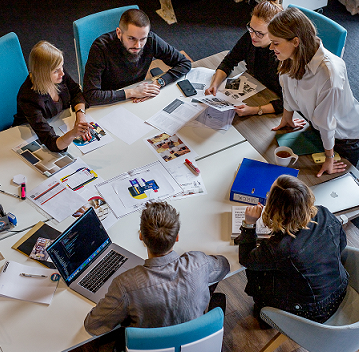In the IT world the idea of a hackathon is widely known and very popular. This is a very good opportunity to test your programming skills, free up creative resources and test your presentation skills. So when we got the invitation from Sandoz, one of the world’s largest drug manufacturers, we didn’t hesitate for a moment. We knew we just had to be there. And we were. What’s more, we brought back one of the three awards with us! How did this happen? You must read on.
The invitation was sent to us by Digital Knights, (a network of elite software development companies) which we are part of (fireup.pro profile on DK). Then Joscha from Hacking Health Berlin contacted us and presented the challenges and topics of the hackathon. The event aimed to generate ideas to digitalize processes within a company which is a large corporation itself and is also part of another medical conglomerate in Novartis Pharma. Projects from scratch and scaling are our specialty! We knew that it was worth going and presenting our skills. We love to hack!
Challenges (topics) of the hackathon
The organizer divided the event into 5 colour zones, which corresponded to 5 different problems that the company is currently facing:
- Challenge yellow zone – How to become a one-stop shop unlocking the potential of our portfolio?
- Challenge blue zone – Re-imaging our customer experience: How to become customer-obsessed fuelled by data?
- Challenge green zone – How to reduce our carbon footprint as an organization?
- Challenge red zone – Enhance generics forecasting by leveraging machine learning.
- Challenge purple zone – Machine Learning on Scientific Data for faster development.
What was our decision-making process like? We analyzed the description of each topic, met in a larger group and tried to create potential teams that could work on each of the challenges. Finally, two three-person teams emerged and went to Munich to work out the best possible solutions:
- The Green Zone challenge or how to reduce the carbon footprint of the organization?
- The Blue Zone challenge or how to maximize user experience based on data (redefining user experience)?
Preparations
There was no end to the creative ideas for the Green Zone topic! We made plans to reduce water and electricity consumption, segregate and recycle waste, congratulate for commuting to work by public transport, cycling, or going by scooters. We were thinking about creating a web and mobile application that would enable employees to mark their progress in reducing their carbon footprint, and in addition, statistics would allow them to compete within the entire organization. We had to wait until the hackathon for the implementation, but since the team consisted of 1x FE and 2x BE, we could have thought about the potential technology we would use for the implementation. Due to the speed and ease of backend implementation in JS, our choice was node.js. What is more, we considered creating an app in React.js, depending on how much time we would finally have for coding. Before leaving, we prepared a library of components, which we could potentially use during development work.

The second team, whose task was to redefine user experience, had to remember what are the ways of researching and designing the user experience. Additionally, we were wondering what kind of Data Science solutions we could use to automate this process. Fortunately, among the team members, there was a specialist in this field (data scientist) and a backend one, who together can build sensational solutions. The team complemented the business analyst who, thanks to their experience in human-centered service design, supported the team with domain knowledge about users’ experiences.
Unexpected turn of events
Getting to the venue of the event turned out to be a huge challenge! Why? Because that was the day when the strike of the airlines that operated our route began. Our flight was also canceled. But fireup.pro never gives up, so we found a way out. We got to Munich by car. After a few hours of driving, we arrived at the Atlas Design Office in Munich at 9:00 a.m. Ready to create and implement solutions to the challenges facing Sandoz.
The Hackathon
Hackathome was not the classic hackathon we know from the IT world. This time we focused on conceptual workshops using the Design Thinking method, which allows us to generate many ideas in a short time. The basic idea is to get each team through a six-stage process, where each team consists of people with different experiences, knowledge, and roles in their organizations. The pillar of this creative method is to put the user in the center of interest (human-centered design), and thus, to search for such solutions that will maximize their experience and meet their expectations, and as a result, satisfy their needs.
Before we started working properly, we had to meet the people we were supposed to work with. We knew earlier that our teams will be joined by business representatives, i.e. specialists from Sandoz and Novartis, as well as invited external experts (business strategists, designers) and guests (doctors, lawyers). We were very lucky because our teams were complemented by really amazing people:
- Ben Lenk-Ostendorf – a psychologist, innovator of change, seeker of solutions to stop the process of climate change;
- Tim Reineke – Head Marketing Channel Management at Hexal / Sandoz;
- Marko Mitric – Head Customer Engagement at Sandoz.

Although we met only on Friday morning, we were able to communicate immediately. As time went on, we got along even better and our visions were convergent. By working together, we could maximize the positive impact of the proposed solutions on the company’s business strategy and adjust to its needs.
Day one
The first day of the hackathon was aimed at three stages of the process: understanding the challenge, deepening the knowledge of the subject, and generating concepts. In the beginning, Sandoz employees talked about the challenges that the company is currently facing. The hackathon participants then had the opportunity to ask the employees questions to clarify their understanding of the topic and the needs of the different user groups of the problems. In the next step, experts were invited to join the teams – not only employees of different departments of Sandoz, but also specialists from external companies, such as DesignIt, HackingHealth, or STUDIO.WHY, who supported the teams with their professional expertise and creativity. At the stage of generating ideas, we used various tools that allow us to give free rein to our imagination, such as the worst idea, other brand comparisons, 635, etc. It is said that the more crazy the idea is, the more innovation it brings. This part of the work has exhausted our life energy, so we ended the first day here.
Second day
Saturday, the second day of the hackathon, was in fact mostly focused on prototyping the potential solutions realized the day before. The teams were building the processes and presented their actions by means of mock-ups, videos, graphics, or Lego bricks. We consulted the mentors and experts who participated in the event that day. We implemented feedback in the form of improvements to the project and consulted again. At the end of the day, the teams had a vision of their solution and started preparing for the final presentation on the last day of the hackathon.
Day three
On Sunday morning, the teams immersed themselves in the preparation of the presentation, to give it back to us by 14:00, and we also worked out our pitches. According to the hackathon rules, we had 3 minutes to present our solution and during this time we had to convince the jury of our idea. The jury evaluated such features of the project as maturity, feasibility, business impact, challenge fit, radical thinking. Moreover, during the next 2 minutes, the jury could ask the teams questions in order to dispel any doubts they might have. After the performance, we were all very satisfied because the jury’s reactions were very promising and the questions were not offensive. We were of good cheer. Good for you!

The results were announced shortly afterwards. The verdict was very satisfactory because Men in Green, working on the ‘green’ challenge, were among the winners! The remaining projects, which were awarded, implemented solutions in the scope of themes 4 and 5:
- Challenge red zone – Enhance generics forecasting by leveraging machine learning.
- Challenge purple zone – Machine Learning on Scientific Data for faster development.
A few words of summary
Today, hackathons aren’t just about coding from morning till night. And indeed, coding was not at the forefront at the event, but we had the opportunity to do something much more important. We prepared the whole process of implementing the solution. It directly translated into improvements concerning the challenge expressed in particular business zones. Is there room for software developers? Definitely yes! Technical employees, strategic employees, innovators, and business representatives can create a very explosive mixture. However, using the tools provided by the Design Thinking method, the cooperation of such multidisciplinary team results in terrific ideas that can bring huge benefits when implemented in the organization. We recommend everyone taking part in such an event.

